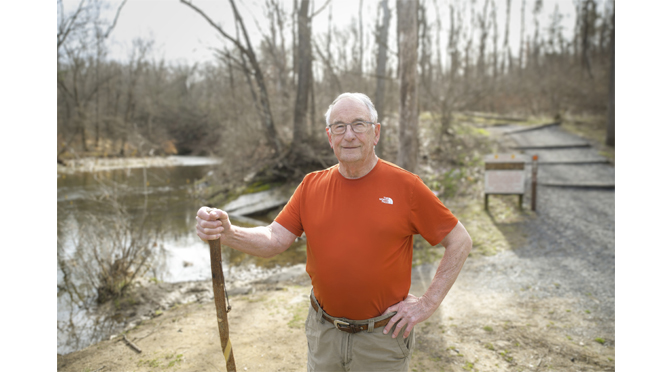When Rick Edmund conquered the hike up a butte in South Dakota’s Custer State Park with his granddaughter last year, he had a big smile on his face and offered a huge shoutout.
Rick, 75, pastor at Chapman Quarries United Methodist Church in Bath, recorded thank you videos to Steven Stevens, MD, FHRS, and James Gallagher, MD, of St. Luke’s Cardiology Associates.
If not for the extraordinary cardiovascular care that has led to St. Luke’s being ranked among the leading heart and vascular centers in the nation, Rick may have never made that climb in Custer State Park – or any of the other climbs – as he and granddaughter Elisabeth trekked through North and South Dakota, visiting several national parks.
Rick was trying to live with persistent atrial fibrillation (AFIB) that was robbing him of his active lifestyle last year. Before that, he had been an active hiker, walker and had been working out at two gyms, but those activities went by the wayside as he had trouble catching his breath while struggling to climb the church steps.
He knew he had lifelong blood pressure issues – for which he was on medication – but nothing prepared him for the struggle to breathe during activity that started last spring.
When he told his primary care physician of his struggles, she referred him to Dr. Gallagher, who examined Rick and referred him to Dr. Stevens, the director of Cardiac Electrophysiology-Device and Ambulatory Service Lines for St. Luke’s University Health Network for an ablation.
An ablation is used to correct the electrical signals that cause the heart to go into AFIB or other heart arrhythmias. The electrophysiologist will run the catheter to the heart from veins in a patient’s leg.
“Mapping” is done when a 3D model of the heart is generated from those catheters and locates the abnormal electrical activity that is triggering the arrhythmias.
“Mapping is GPS for the heart.” Says Dr Stevens. For AFIB, the most common culprit area is from the pulmonary veins, and the procedure is called pulmonary vein isolation. The catheter tip then heats up or freezes to create a small amount of scar tissue and stops that area from firing inappropriately, allowing the heart’s electrical system to work properly again.
“Rick is a really good guy and very interesting,” Dr. Stevens said. “He had persistent AFIB, which means he was in it all the time. He was symptomatic and it affected his lifestyle. He’s a pastor, he hikes.”
Rick went back into AFIB three days after the ablation, and Dr. Stevens knew something else had to be done, as it is relatively common for AFIB to recur transiently early after an ablation.
“We did a cardioversion for Rick,” Dr. Stevens said. “It’s like a reset for the for the heart, not a cure for AFIB.” Cardioversion uses external electrodes to send mild shocks to the heart and return it to a normal rhythm.
“The ablation fixed the arrhythmia, the cardioversion just reset the heart,” Dr. Stevens said. “This wasn’t unexpected or a complication. If we didn’t do the ablation, just the cardioversion, the heart couldn’t hold the normal rhythm like it does now and he would be going back into AFIB.”
“I recovered from that one right away,” Rick said. “I came out of it and have felt pretty good ever since.”
Rick has been hiking every week since, heading frequently to Jacobsburg Park. He is very much enjoying being active again. He’s especially proud of his performance on a stairclimbing machine, chalking up 180 flights in 30 minutes.
“The World Trade Center was 110 flights,” Rick chimed. “Make sure Dr. Stevens and Dr. Gallagher know I did that.”
“I’d like to thank Dr. Gallagher for referring Rick to me,” Dr. Stevens said. “And it was really striking to see Rick’s video, to see him smile and thank me and Dr. Gallagher. It’s touching that he was even thinking of us when he climbed that mountain. It is gratifying that we helped restore his quality of life, activity, and happiness. It really does take a village to heal a patient.”
About St. Luke’s
Founded in 1872, St. Luke’s University Health Network (SLUHN) is a fully integrated, regional, non-profit network of more than 20,000 employees providing services at 15 campuses and 300+ outpatient sites. With annual net revenue of $3.4 billion, the Network’s service area includes 11 counties in two states: Lehigh, Northampton, Berks, Bucks, Carbon, Montgomery, Monroe, Schuylkill and Luzerne counties in Pennsylvania and Warren and Hunterdon counties in New Jersey. St. Luke’s hospitals operate the largest network of trauma centers in Pennsylvania, with the Bethlehem Campus being home to St. Luke’s Children’s Hospital.
Dedicated to advancing medical education, St. Luke’s is the preeminent teaching hospital in central-eastern Pennsylvania. In partnership with Temple University, the Network established the Lehigh Valley’s first and only four-year medical school campus. It also operates the nation’s longest continuously operating School of Nursing, established in 1884, and 45 fully accredited graduate medical educational programs with more than 400 residents and fellows. In 2022, St. Luke’s, a member of the Children’s Hospital Association, opened the Lehigh Valley’s first and only free-standing facility dedicated entirely to kids.
SLUHN is the only Lehigh Valley-based health care system to earn Medicare’s five-star ratings (the highest) for quality, efficiency and patient satisfaction. It is both a Leapfrog Group and Healthgrades Top Hospital and a Newsweek World’s Best Hospital. The Network’s flagship University Hospital has earned the 100 Top Major Teaching Hospital designation from Fortune/PINC AI 11 times total and eight years in a row, including in 2023 when it was identified as THE #4 TEACHING HOSPITAL IN THE COUNTRY. In 2021, St. Luke’s was identified as one of the 15 Top Health Systems nationally. Utilizing the Epic electronic medical record (EMR) system for both inpatient and outpatient services, the Network is a multi-year recipient of the Most Wired award recognizing the breadth of the SLUHN’s information technology applications such as telehealth, online scheduling and online pricing information. The Network is also recognized as one of the state’s lowest cost providers.
Information provided to TVL by:
Sam Kennedy




